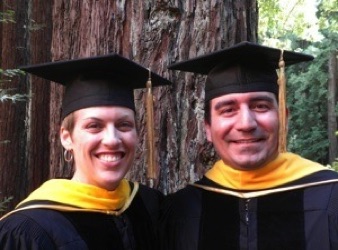Dr. Frank RIvera III
Thesis abstract:
Nitroxide free radicals have been utilized in many areas in chemistry due to their stability and long life. In this thesis, nitroxides are used to quench the fluorescence of organic and inorganic fluorophores, as well as to prepare designed polymers using nitroxide mediated polymerization (NMP).
The ability of nitroxides to quench the fluorescence of quantum dots was examined. The study found fluorescence quenching was affected by the binding affinity and the distance between the nitroxide and the quantum dot. Amino pyrrolidine nitroxide 2.1 was synthesized in an attempt to maximize quenching by minimizing distance between quencher (nitroxide) and fluorophore (quantum dot). It was found that intramolecular hydrogen bonding decreased the binding affinity and therefore the quenching efficiency of this nitroxide.
The phenomenon of fluorescence quenching was extended to organic dyes. Profluorescent nitroxides are a class of compounds that consist of an organic fluorophore covalently linked to a nitroxide. Profluorescent nitroxides Dansyl-TEMPO (D-TEMPO), Dansyl-pyrrolidine (D-py), pyrene-TEMPO, 4-(3-hydroxy-2-methyl-4-quinolinoyloxy)-2,2,6,6,-tetramethylpiperidine-1-oxyl nitroxide (QT), 4-(3-carboxy-7-dimethylaminocoumarin)-2,2,6,6,-tetramethylpiperidine-1-oxyl nitroxide (COT), and 4-(3-carboxy-7-dimethylaminocoumarin)-2,2,6,6,-tetramethylpiperidine-1-oxyl nitroxide (CNT) were synthesized and used in a study to detect urushiol, the toxic constituent of poison oak and ivy. The detection system utilizes B-n-butylboronic acid to couple with urushiol to form a boronic ester intermediate, which is then attacked by the profluorescent nitroxide, liberating a primary butyl radical. This radical is trapped by another equivalent of profluorescent nitroxide, restoring fluorescence to the diamagnetic product. Fluorescent studies probed the efficacy of these profluorescent nitroxides. Field studies were conducted using D-TEMPO, and demonstrated the efficacy of the system. However, attempts to extend this sensor to catecholamines in aqueous solution demonstrated that the dansyl chromophore is sensitive to the presence of water.
TIPNO-based initiator was synthesized and employed in nitroxide mediated polymerization. Well-defined polymers containing protected thiol moieties on the side chain were constructed. Deprotection provided polymers containing thiol pendants, which were oxidized and reduced to demonstrate control over disulfide crosslinking. Manipulating the conditions of oxidation controlled the intamolecular crosslinking to form nanoparticles, or intermolecular crosslinking with other chains to form a network of disulfide-linked polymers.
Ph.D. 2011: “The Use of Nitroxides in Controlled “Living” Polymerization of Thiol-Functionalized Polymers and as Quenchers of Quantum Dots and Organic Fluorophores: Profluorescent Nitroxides as Sensors for Urushiol from Poison Oak, Ivy, Sumac”
May 2008 campus-wide UCSC Teaching Assistant Award
BS Chemistry, UCSC
ACCESS student at UCSC from Monterey Peninsula College
Frank is a chemistry faculty at Monterey Penninsula College
Publications with the Braslau Group:
C. Tansakul, E. Lilie, E. D. Walter, F. Rivera III, A. Wolcott, J. Z. Zhang, G. L. Millhauser, R. Braslau* “Distance-dependent Fluorescence Quenching and Binding of CdSe Quantum Dots by Functionalized Nitroxide Radicals,” J. Phys. Chem. C, 2010, 114, 7793-7805. doi: 10.1021/jp1005023.
R. Braslau,* F. Rivera, III, E. Lilie, and M. Cottman “Urushiol Detection using a Profluorescent Nitroxide,” J. Org. Chem. 2013, 78, 238-245. doi: \10.1021/jo301135m.
R. Braslau,* F. Rivera, C. Tansakul “Reversible Crosslinking of Polymers bearing Pendant or Terminal Thiol Groups Prepared by Nitroxide-Mediated Radical Polymerization,” Reactive and Functional Polymers, 2013, 73, 624-632. \http://dx.doi.org/10.1016/j.reactfunctpolym.2013.01.009.




non-identical “twins”
Dr. Rushia Turner and Dr. Frank Rivera III
Frank and Brandy